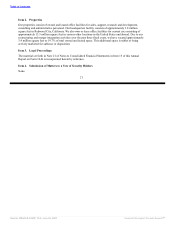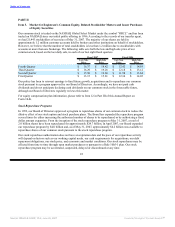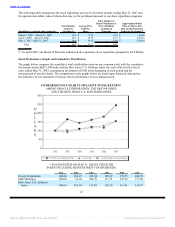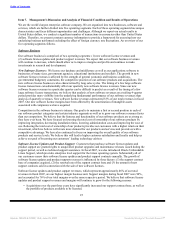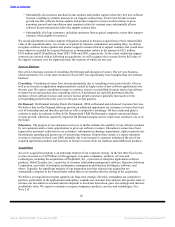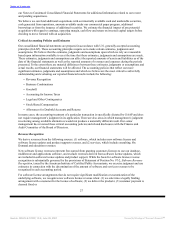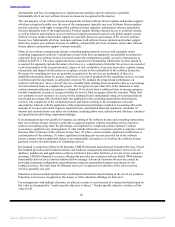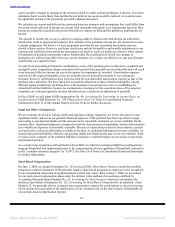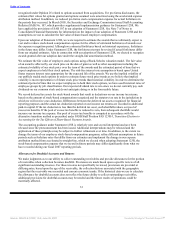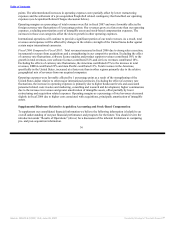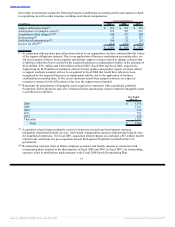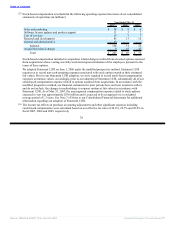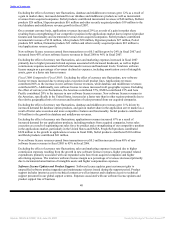Oracle 2006 Annual Report Download - page 35
Download and view the complete annual report
Please find page 35 of the 2006 Oracle annual report below. You can navigate through the pages in the report by either clicking on the pages listed below, or by using the keyword search tool below to find specific information within the annual report.
Table of Contents
For a given acquisition, we may identify certain pre-acquisition contingencies. If, during the purchase price
allocation period, we are able to determine the fair value of a pre-acquisition contingency, we will include
that amount in the purchase price allocation. If, as of the end of the purchase price allocation period, we are
unable to determine the fair value of a pre-acquisition contingency, we will evaluate whether to include an
amount in the purchase price allocation based on whether it is probable a liability had been incurred and
whether an amount can be reasonably estimated. With the exception of unresolved tax matters, after the end
of the purchase price allocation period, any adjustment to amounts recorded for a pre-acquisition contingency
will be included in our operating results in the period in which the adjustment is determined.
Goodwill
We review goodwill for impairment annually and whenever events or changes in circumstances indicate its
carrying value may not be recoverable in accordance with FASB Statement No. 142, Goodwill and Other
Intangible Assets. The provisions of Statement 142 require that a two-step impairment test be performed on
goodwill. In the first step, we compare the fair value of each reporting unit to its carrying value. Our reporting
units are consistent with the reportable segments identified in Note 15 of the Notes to Consolidated Financial
Statements. If the fair value of the reporting unit exceeds the carrying value of the net assets assigned to that
unit, goodwill is considered not impaired and we are not required to perform further testing. If the carrying
value of the net assets assigned to the reporting unit exceeds the fair value of the reporting unit, then we must
perform the second step of the impairment test in order to determine the implied fair value of the reporting
unit’s goodwill. If the carrying value of a reporting unit’s goodwill exceeds its implied fair value, then we
would record an impairment loss equal to the difference.
Determining the fair value of a reporting unit involves the use of significant estimates and assumptions. These
estimates and assumptions include revenue growth rates and operating margins used to calculate projected
future cash flows, risk-adjusted discount rates, future economic and market conditions and determination of
appropriate market comparables. We base our fair value estimates on assumptions we believe to be reasonable
but that are unpredictable and inherently uncertain. Actual future results may differ from those estimates. In
addition, we make certain judgments and assumptions in allocating shared assets and liabilities to determine
the carrying values for each of our reporting units. Our most recent annual goodwill impairment analysis,
which was performed during the fourth quarter of fiscal 2007, did not result in an impairment charge.
Accounting for Income Taxes
Significant judgment is required in determining our worldwide income tax provision. In the ordinary course
of a global business, there are many transactions and calculations where the ultimate tax outcome is uncertain.
Some of these uncertainties arise as a consequence of revenue sharing and cost reimbursement arrangements
among related entities, the process of identifying items of revenue and expense that qualify for preferential
tax treatment, and segregation of foreign and domestic income and expense to avoid double taxation.
Although we believe that our estimates are reasonable, the final tax outcome of these matters could be
different from that which is reflected in our historical income tax provisions and accruals. Such differences
could have a material effect on our income tax provision and net income in the period in which such
determination is made.
Our effective tax rate includes the impact of certain undistributed foreign earnings for which no U.S. taxes
have been provided because such earnings are planned to be indefinitely reinvested outside the United States.
Remittances of foreign earnings to the U.S. are planned based on projected cash flow, working capital and
investment needs of foreign and domestic operations. Based on these assumptions, we estimate the amount
that will be distributed to the U.S. and provide U.S. federal taxes on these amounts. Material changes in our
estimates could impact our effective tax rate.
We record a valuation allowance to reduce our deferred tax assets to the amount that is more likely than not to
be realized. In order for us to realize our deferred tax assets, we must be able to generate sufficient taxable
income in those jurisdictions where the deferred tax assets are located. We consider future market growth,
forecasted earnings, future taxable income, the mix of earnings in the jurisdictions in which we operate and
prudent and feasible tax planning strategies in determining the need for a valuation allowance. In the event we
were to determine that we would not be able to realize all or part of our net deferred tax assets in the future,
an adjustment to the deferred tax
31
Source: ORACLE CORP, 10-K, June 29, 2007 Powered by Morningstar® Document Research℠


